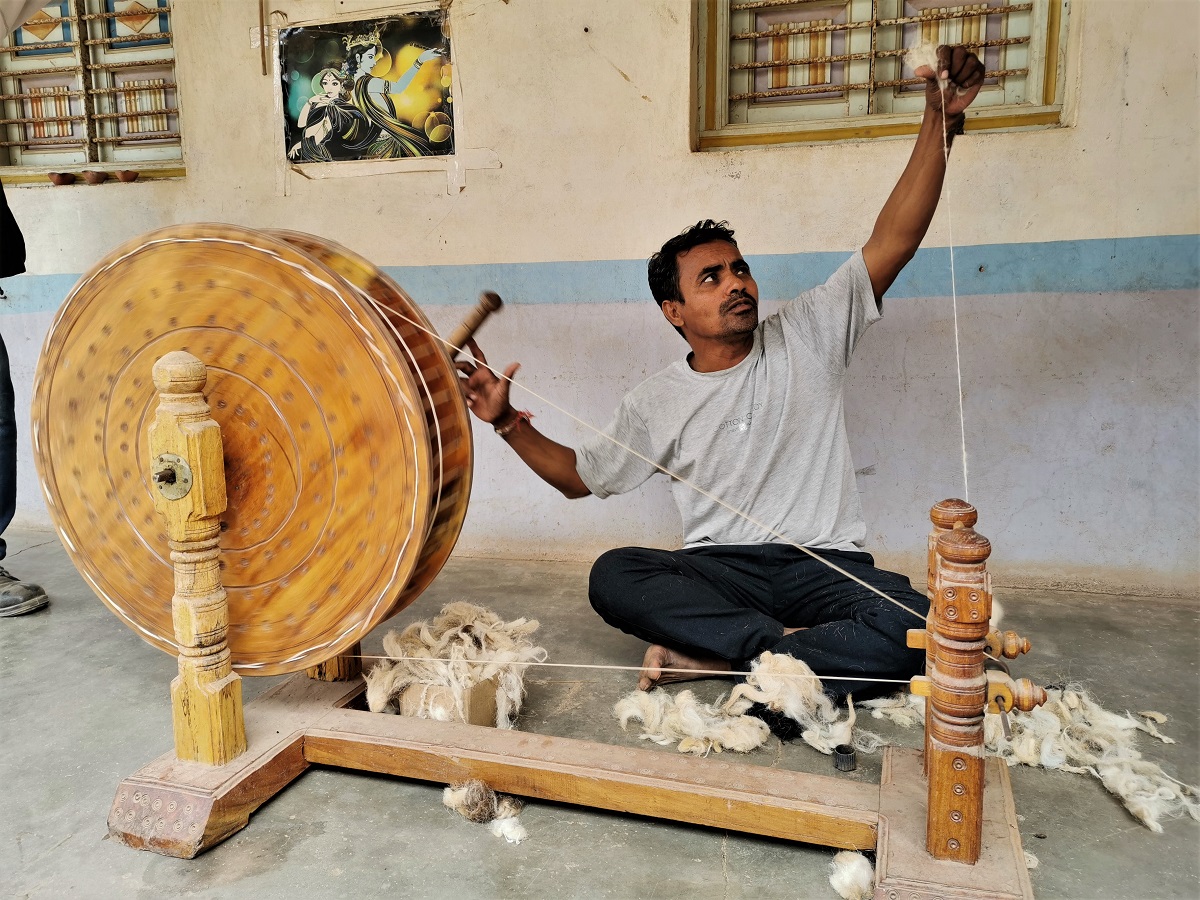The Ranns, deserts, artisan villages, stepwells of Gujarat, and much more… in 9 stories… this is ‘story 6’


Co-authored & edited by my travel companion – Shoba Nayar

Exploring the Great Rann of Kutch – Day 2
(Click on the photos to open and see fully)

Chilly mornings in the desert
India is often thought of as a hot country but winter in the desert can be cold and on arising the next morning, there was a decided chill in the air as I gazed out and watched the sun rise over the lake below. A serene scene filled my view as a boat glided along silently, trawling for the day’s catch.

Visiting an NGO and observing the craftspeople at work
We drove out to the Rann again and visited several villages. Here, we watch the village woman grouped together under a bright canopy intricately stitching cloth using an ancient art form handed down from generation to generation.

I watched one lady, adept at the craft, chatting, smiling, and creating the stitches at a measured distance—each neat, tidy, and delicately performed with minute precision. What an amazing art, what an amazing experience.

This was the ‘Kala Raksha Kendra’ non-government organisation, a grassroots social enterprise, developed in 1993 and dedicated to preserve the traditional arts in the desert region of Kutch. The community are experts in art and design with many pieces being housed in museums to document the existing traditions of heirloom textiles, innovation, and the region’s unique style.
Megi Ben Meriya: Veteren craftswoman

We visited Megi Ben Meriya, a 72 year old veteran of the craft of stiching who, since the massive devestating earthquakes of 2001, has taken to making stitched patchwork maps to document Kutch and the Rann lifestyle from her own memories.


She talked about pre and post earthquake as past life and new life as she sat in the full midday sun on her day bed, almost toothless with sunbaked dark wrinkled skin but with a smile that melted our hearts. She has recently been to the USA to demonstrate her craft and give lessons, and talked about her plans to go back on another visit.


Artisan shawl making from raw materials
One young artisan, working from his home, was carding and spinning local wool on his front porch as we approached. (see main photo) He carried on working as we talked and he explained he uses organic and non-organic cotton, wool, silk, linen, and some bamboo. Inside, in his shop, he demonstrated local traditional blankets and beautiful wraps and shawls.

Rogan Art: an ancient Persian art
At the home of the Khatri family’s Rogan Art studio, we were treated to a demonstration of this Persian art form whereby this family is the only one now carrying out this craft in India.

The artist, who has a Masters in Art, showed us how the ‘paint’ is created from natural colours (made by themselves) and a process of making a resin from boiling down the castor oil plant which is then applied to the cloth using delicate strokes of a pointed metal stick, a little like a fine crochet hook.




Sometimes it is painted onto one side of the cloth which is folded to created a ‘mirror image’, and sometimes whole pieces are produced in single form of strokes and dots. The beauty of the designs had us gasping with delight as they laid piece by piece in front of us and we admired the trophy pieces on the walls for which they have won many awards.

They have been living in this area for over 300 years and the craft has continued over at least 8 generations—prior to that they do not know the history of their family and the work they did. I purchased a small Tree of Life, gold paint on green cloth, and fondly remember this visit as I see it very day in my home.
Of copper workers and cow bells

There are many artisan families in Kutch, and many carry the traditional arts forward from hundreds of years of family traditions. Visiting one of the copper bell makers we were given a demonstration of how they heat, mould, and link the copper pieces before baking in mud, clay, and minerals to bring out the amazing colours of the metal elements.

These minerals of zinc, copper, and other elements—except lead—give the bells a nice tinkle rather than an otherwise dull sound. They were crafted into working bells for the cows, sheep, camels, and goats.

They also make more decorative gift items for the home, and their shop was full of treasures. It was hard to keep the purchases to a minimum knowing they needed to be carried home, but one special little bell was packed for me to remember this occasion and given as a gift to a special girl.
Lacquer workers
Another fascinating craft family we visited were lacquer workers who hand lathed wooden rolling pins, massage rollers, spoons and serving ladles, all lacquered with shining bright colours mixed with resin and natural oils or elements (e.g., neem/green, river stone/red, turmeric/yellow).



Exploring the city of Bhuj
Leaving the artisans of Kutch behind, we went to the nearby city of Bhuj and spent time visiting the 18th century ‘Aina Mahal’ (literlaly translates to ‘Palace of Mirrors’) which was built around 1750 by Rao Lakhpatji of Kutch.

Designed by Ram Singh Malam, who had mastered the craft and skill of European architecture in his 18 years in Europe, it was built in the local style but decorated with European tiles, mirrors, and glass. Construction began in 1865 and was completed in 1879.




Within the ancient walls of the palace museum



The Palace, which is now a museum stands alongside the ‘Italian Gothic Style’ Prag Mahal in Darbargadh. It has also been likened to the Romanesque architecture twist on the Indo-Saracenic Revival style with semi circular arches often seen in Medieval Europe.

The historical ‘New Palace’
The 2001 earthquakes severely damaged much of the palace and following a massive burglary, where antiques and other items were damaged or stolen in 2006, the palace was left in a ghostly state. Restoration began sometime later and the bell tower and some areas have been open to the public for viewing, whilst other areas are still under restoration.



We climbed the tower for magnificent views over the city and watched the sun come down to the chorus of a flock of green parrots resident in the walls and crevices.


The view from above the ancient palace and the city of Bhuj


From up in the tower, one also get a bird’s eye view of the 450 year old ruined palace across the courtyard beside the Aina Mahal, and feel the ancientness of the times when it was the thriving kingdom’s main palace, full of life and energy.



Observing the owls
Our guide Ajay was a keen photographer and a few days before had spotted some owls roosting in the ruined alcoves. He took us to where they were, hoping for a glimpse, and we were treated to a wonderful viewing with this amazing palace backdrop for our photographic efforts.




Preserving and displaying the local art in museums
On the outskirts of the city we visited a large and very modern museum of local artisans where women and school groups also have activities to learn about the art and history of these local artisans, crafts stretching back centuries, and how these techniques are used today. In the museum, the ‘models’ were dressed with the intricately stitched and mirrored garments depicting different tribes, their origins, and the timeline of the different ‘fashions’. (Unable to be photographed)

Block printing – quite an art
Nearby the museum we visited a factory of block printing, where lengths of cloth were dyed in big tubs, block printed and dried on the ground in the large open yard in the hot sun before going to market.




A temple visit at sunset
Before returning to our retreat for one last night, we visited a Krishna Temple of Swami Narayana. Built post the 2001 earthquake, combining land in the city with some smaller scattered holdings into one large project, it was a huge place and we arrived in time for the evening Aarti. As we circumambulated the temple (ritual walking around a temple or sacred place) in the clockwise direction, as is common in many sacred places, the sun was setting and the effect was mesmerising, adding to the charm of the visit and affording, once again, a great photo opportunity.

Story 7…’Ahamedabad‘ coming soon.
Travel organised with Suresh Bahuguna at Lotus India Journeys!
http://lotusindiajourneys.com/index.php
#greatrannofkutch #kutch #kutchdiaries #gujarattourism #gujarat #instagram #india #kutchi #kutchtourism #travel #incredibleindia #ourkutch #travetheworld #worldtraveller #worldtraveler #lettheadventurebegin #kutchsafaricamp #teresaglobaltraveller #photooftheday #followme #toptags #nature #photooftheday #sun #naturebrilliance #picture #travel #lovemyphotos #india #naturephotography #nature_lovers #photography #photogram #theoutdoorfolk #teresaglobaltravels #traveltheworld #travelindia #travelgujarat #teresatraveller


Stunning beauty of the Mother Nature is such a nurturing and meditative experience to be in.
Breathtaking views of her choicest destinations with exquisite colours, shades and her serene creations are well described above.
A journey feeling her heart throbs through her sacred spaces, softly kissing her with every gentle foot steps are truly a rejuvenating and transformational process to the mankind 👏 ❤
My apologies for the late reply, I missed this when it came through – Thankyou Mahesh for your poetic message – Namaste and thankyou Teresa